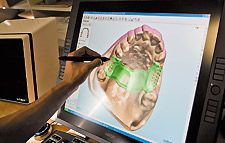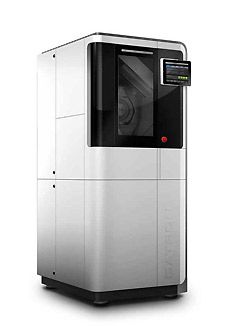Crossover appeal
There’s always a lot to see while walking the crowded confines of the Lab Day exhibit hall and last month’s show in Chicago didn’t disappoint with companies of all sizes showing off their latest products of both low and high tech varieties. But it should come as no surprise that my gaze was often drawn to the computer-powered end of the spectrum where I was not disappointed by the latest in CAD/CAM scanners, mills, printers and software.
There’s always a lot to see while walking the crowded confines of the Lab Day exhibit hall and last month’s show in Chicago didn’t disappoint with companies of all sizes showing off their latest products of both low and high tech varieties. But it should come as no surprise that my gaze was often drawn to the computer-powered end of the spectrum where I was not disappointed by the latest in CAD/CAM scanners, mills, printers and software.
While checking out the new capabilities of all of these dental-lab specific technologies, I couldn’t help but notice a few brand names that in the past would have been much more likely to be found at the local Best Buy rather than on the show floor at one of the largest dental lab events around. But there they were.

The crowds gathered around to see a live demonstration of CadBlu’s Digital Partial Design Station were watching the 3D CAD process taking place on an interactive pen display from Wacom, a company known as a leader in interactive computer input devices often found in graphic design and photo processing firms. Then, down another aisle there was a new large-scale mill from Datron with an Apple iPad serving as a removable touchscreen control.
The integration of these consumer grade technologies into dental laboratory applications should come as no surprise. When considered as an industry, the dental lab business is rather small in scale with a specific focus. So rather than spend precious R&D resources developing interface and control technologies, it makes sense for companies creating high tech dental lab systems to adapt something “off the shelf.”

This seems like a trend that is likely to continue, and may even expand. It’s definitely a trend that can benefit everyone involved. Companies developing new technologies and systems can bring breakthroughs in scanning and dental restoration design to market faster if the way users will interact with those systems doesn’t need to be reinvented along the way. This also decreases the cost of the systems. Users of these technologies can pick up and run with them, because there is less to learn along the way.
This also brings up the possibility of having one device control all of the technology in the lab. Just as consumer electronics companies are developing integrated technologies for the home that will allow centralized and mobile control over lights, heat settings, appliances and even TV channels, it seems perfectly feasible for a lab to have one control panel that can send commands to a scanner, a mill, a printer, a furnace and even light, air and gas controls at the workbench.
All the technology capable of to doing this is already here today; it’s really just a matter of integration. In some cases that integration will need to come from the top down. Until a piece of lab technology has some kind of wired, Wi-Fi or even Bluetooth connectivity, controlling it from a central device is not possible. For other systems applying a common interface may not work completely. The Wacom display used by CadBlu might be able to work with a number of systems out of the box, but for it to really work it’s magic completely, the software it’s controlling needs to be optimized for the interface.
However, there are backdoors to letting one device such as an iPad take control of existing systems that are powered by computers. Applications such as LogMeIn and GoToMyPC allow an iPad or a laptop to remotely control the screen of any computer, providing access from anywhere. This remote access seems like an ideal use for a tablet such as the iPad, and while the device might not have the processing power for high intensity CAD applications, the magic of these programs is that the iPad is just providing an interface and the computer being controlled remotely is doing the heavy lifting.
And of course the iPad is already growing more powerful. The just- launched iPad2 is designed to handle processor intensive tasks like editing movie files and programming digital audio. CAD tasks are probably just a few generations away. It really makes sense for the companies creating these systems to look for ways to integrate devices like this with their technology, especially if the start of the digital dental process moves more and more chairside via digital impressions. Then it’s just a matter of designing software as a pass-through to shape that data from an impression to a restoration design exported to a mill or printer that also can be controlled from the same device.

Suddenly running a digital lab can be done from anywhere with access to the Internet. A powerful enough iPad or similar touchscreen tablet could handle everything from dentist-technician communication, managing the flow of patient data, running CAD software for restoration design, managing the production technology for manufacturing those designs and even provide a window into the physical lab environment via remote webcam.
There will always be physical aspects to these processes because robots to load materials and tools into a mill, finish the CAM-produced restorations or package and ship them to dentists are not forthcoming any time soon. But the days when a lab’s digital work can be managed and completed from one device are not all that far off. And because that device will be off the shelf consumer technology, if you do have to take your work home with you, it takes just a few taps on the screen to switch from checking your records, managing your mill and communicating with you your accounts to blowing off a bit of steam by flinging around a few Angry Birds.
Product Bites – January 19, 2024
January 19th 2024Product Bites makes sure you don't miss the next innovation for your practice. This week's Product Bites podcast features new launches from Adravision, Formlabs, Owandy Radiology, Henry Schein Orthodontics, Dental Creations, and Dental Blue Box. [5 Minutes]
Product Bites – December 22, 2023
December 22nd 2023The weekly new products podcast from Dental Products Report is back. With a quick look at all of the newest dental product launches, Product Bites makes sure you don't miss the next innovation for your practice. This week's Product Bites podcast features updated software from Medit. [2 Minutes]